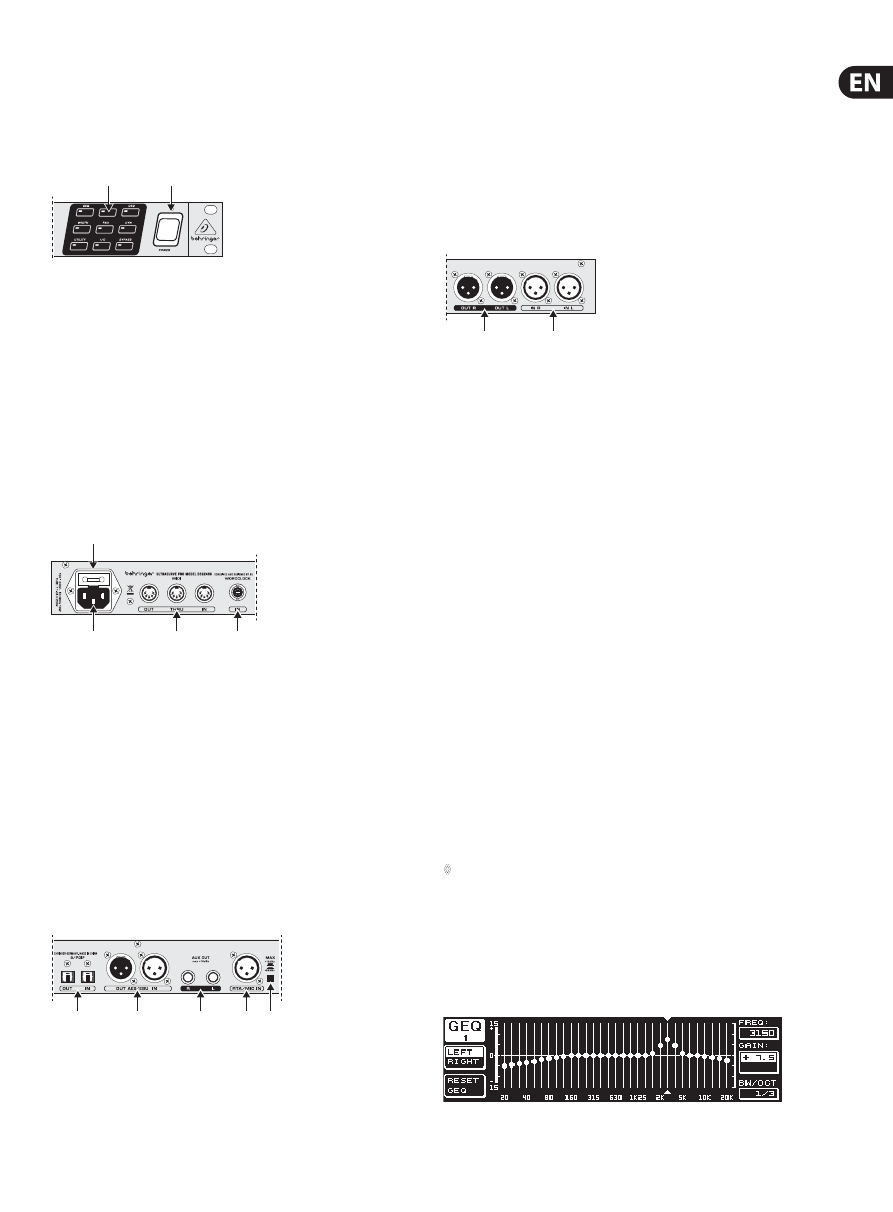
5
ULTRACURVE PRO DEQ2496 User Manual
(9)
The DEQ2496 has three
DATA WHEELS
, which can be used to select and
edit various parameters—again depending on the currently selected menu.
Often, they perform a dual function, i.e. you can edit by turning and pressing
a data wheel. Pressing the data wheels also changes the scaling of many
parameters (step width) or confirms/resets previously made entries.
(10)
(11)
Fig. 2.3: The menu keys of the DEQ2496
(10)
With the menu keys you can select the individual menus of the various
modules. They can also be used to select specific pages from these menus
(like PAGE key). Each of these keys has a built-in LED, which lights up when
the corresponding module starts modifying the sound. When the DEQ2496
receives MIDI data, the LED of the UTILITY key lights up briefly. Keep this
key pressed for about 1 s to bypass active modules or re-activate disabled
ones. This function refers only to those modules which can be edited in
the BYPASS menu (see chapter 3.7).
(11)
Use the
POWER
switch to put the DEQ2496 into operation. This switch
should be set to “Off” before you connect the unit to the mains.
2.2 Rear panel
(12)
(13)
(14)
(15)
Fig. 2.4: Mains, MIDI and wordclock connectors
(12)
The
FUSE HOLDER
holds the mains fuse of the DEQ2496. Blown fuses
must be replaced by fuses of the same type and rating. Please see the
“Specifications” for further details.
(13)
The mains connection is made using the enclosed power cord and a standard
IEC
receptacle.
(14)
The MIDI jacks enable the DEQ2496 to communicate with a computer or
other MIDI equipment. Incoming MIDI data are received on the
MIDI IN
,
outgoing MIDI data are sent via the
MIDI OUT
. Received MIDI data are
also present at the
MIDI THRU
jack, so as to pass them on unmodified
to other devices.
(15)
Use the
WORDCLOCK
input to synchronize your DEQ2496 to external
equipment via a wordclock signal. This connector is on a BNC coaxial jack.
(16)
(17)
(18)
(19) (20)
Fig. 2.5: Digital interfaces and RTA microphone input
(16)
Your DEQ2496 features a digital optical interface for the transmission/
reception of data in both AES/EBU and S/PDIF formats.
(17)
The digital
AES/EBU
interface (XLR connectors) also sends/receives AES/EBU
or S/PDIF signals.
(18)
The
AUX OUT
phone jack is an additional stereo output, which allows you to
tap the audio signal present at the digital outputs in analog form.
(19)
The
RTA/MIC IN
XLR connector can be used to connect a measurement
microphone providing an input signal for the real-time analyzer or SPL
meter. This connector has a switchable +15 V phantom power supply for
condenser microphones and can be set to microphone or line sensitivity
(see chapter 3.11).
(20)
The
MAX
switch raises the maximum level present at the MAIN inputs/
outputs from +12 dBu to +22 dBu.
(21)
(22)
Fig. 2.6: Input and output connectors
(21)
These balanced XLR connectors provide the analog output signal of
the DEQ2496.
(22)
These balanced XLR inputs are used to connect analog input signals.
3. Menu Structure and Editing
This chapter provides you with detailed information on how too use the various
functions on each menu page. We recommend that you keep this user’s manual
available while working with the DEQ2496, so as to use it as a reference in case of
any problems.
3.1 General operation and display structures
When you select a menu with the GEQ, PEQ, DYN, etc. keys, the display indicates
the respective menu structure. To the left and right along the display you
will find functions and parameters for preset editing, which are assigned to
the A and B keys (left) and the three data wheels (right) and can be used for
editing as required.
Most of the menus comprise several pages. The actual number of pages is shown
in the top left part of the display, below the menu name. Use the corresponding
menu key or the PAGE key to the left of the display to switch from one page to the
next and back again.
As the functions performed by the A and B keys and the data wheels depend on
the currently selected menu, all operating steps are described in full detail below.
All menus are dealt with one after the other, and all functions and parameters are
explained explicitly.
◊
Please note that the left and right channels will be edited
simultaneously in STEREO LINK mode.
3.2 Equalizer modules
3.2.1 GEQ menu
Press the GEQ key to enter the GEQ menu. This menu has just one page and allows
you to set all filters as desired.
Fig. 3.1: GEQ menu




































